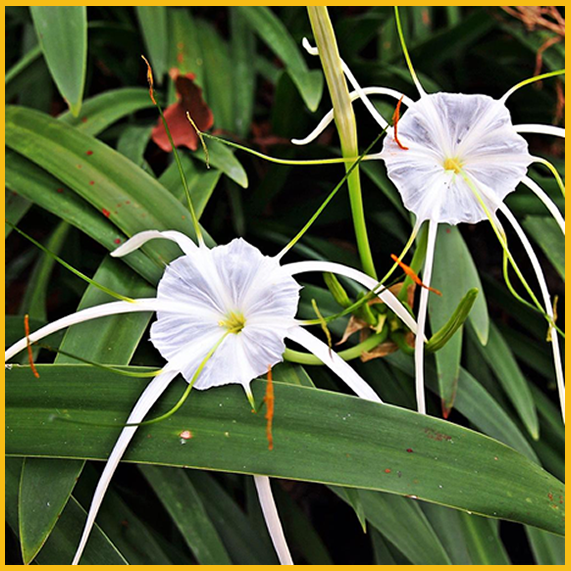Peruvian Daffodil Hymenocallis latifolia

By Michael Harrelson
(This article originally appeared in California Garden, September/October 2019)
For showy summertime excitement in your garden, consider planting Peruvian Daffodil (Hymenocallis latifolia) bulbs. These amaryllis relatives are native to South America, common in the Florida wetlands, and have adapted easily to our San Diego growing environment. Known also as Spider Lily, Ismene, or Basket Lily, this monocot has a spectacular burst of flowers (10 to 16) at the end of a two-foot ovular stalk. Each flower emerges separately, and the stalk will continue to produce blooms for up to two weeks. The flowers have a three-inch pentagonal center with dramatic tendril-like extensions adding another six inches to the diameter of the bloom.
The flower of the Peruvian Daffodil is known for its pleasant fragrance. The plant features a basal clump of amaryllis-type leaves that can stretch out two to three feet. Hymenocallis latifolia bulbs propagate rapidly and a single basal clump can, over a year or two, become a large, dynamic part of your garden. (Balboa Park has a clump that has grown to the size of a Buick.) It is aggressive in its growth pattern but not invasive. Like most bulbs, occasional dividing of the clump will benefit flower production.
Peruvian Daffodils are easy to grow in most areas of San Diego. They like well-drained, organically rich soil, moist but not soggy. The plant should be placed where it gets partial to full sun. Plant bulbs 12–18 inches apart and feed with a high-phosphorous (liquid preferred) fertilizer in the spring. Unfertilized, the bulbs will still do well if they are planted in a bed with a good base of organic material. In our mountains, Hymenocallis latifolia can withstand short spells below freezing temperatures but should be dug up and stored in a cool place during the coldest months. This species of plant is deer-resistant but is a favorite of snails and slugs. It has been reported that mosaic virus can sometimes be a problem, but generally this is a bulletproof addition to the garden.
Of the more than ten varieties of Hymenocallis latifolia, most are white, sometimes with green or yellow stripes. There is a yellow variety (H. Sulfur Queen) available in some nurseries. As a landscape plant it can be placed along garden borders or fence lines if given room for the two- to three-foot leaf spread. It is commonly used along water features to soften the hard edges; it is, however, most effective as a specimen plant—the center of attention. In areas where it does not freeze, the plant is a perennial and, even after the flowers have gone, can add a spark of emerald green all year long to any planting area. It does well in pots if it gets the proper sun. It will not thrive in a fully shaded part of the patio. When in flower, it is a favorite of bees and hummingbirds and would be a welcome addition to anyone interested in an Earth Friendly Garden.
Michael Harrelson has been a UC Master Gardener since 2012. Get free gardening advice on the Master Gardener Hotline, (858) 822-6910, or by email at gro.dsrenedragretsamnull@pleh. Due to COVID-19, the Master Gardener Hotline staff members are working remotely to ensure they respond to your questions in a timely manner.

